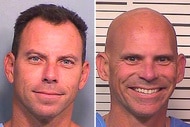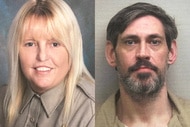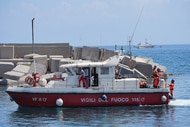Create a free profile to get unlimited access to exclusive videos, breaking news, sweepstakes, and more!
Identification Efforts Renewed For Four Victims Of 1973 Arson That Targeted New Orleans Gay Club
The UpStairs Lounge was torched on June 24, 1973, killing 32 people — four of whom remain unidentified or unaccounted for. For decades, the deadly blaze marked the largest massacre of LGBTQ people in the country’s history.

City officials in New Orleans have renewed efforts to recover and identify several victims who were killed after a gay bar in the French Quarter was set ablaze in 1973, killing dozens.
The UpStairs Lounge fire, which claimed the lives of 32 people, gained nationwide notoriety as the largest massacre of LGBTQ people in U.S. history. Nearly half a century later, the arson is still the deadliest fire on-record in New Orleans.
On Thursday, the city council passed a motion to "take any and all appropriate steps necessary" to "facilitate the recovery" of four fire victims — three of whom are unidentified — whose remains were scattered in unmarked graves in the city's potter's field.
The motion was spearheaded by Councilmember JP Morrell.
“No one notified the families, and the families were not provided the opportunity to come forward to claim the remains,” Morrell said during a council meeting on Aug. 4. “We are now moving with this resolution to push forward with all due haste to make every resource available from the City of New Orleans to help these families properly interred and take into possession the remains of their loved ones who have been discarded in a potter’s field.”
Someone lit a fire in the stairwell entrance to the UpStairs Lounge on June 24, 1973. The building caught fire, trapping and killing 32 people. No one was ever convicted.
Roger Dale Nunez — a disgruntled customer and gay man who had been kicked out of the bar earlier on the day of the arson — was suspected of starting the fire, according to NPR. He killed himself in 1974.
Until the 2016 Pulse nightclub shooting in Orlando, the UpStairs Lounge fire was the country’s largest mass murder of LGBTQ people.
"Poor record-keeping and indifference continue to hamper the efforts of surviving family members to reclaim the bodies of victims and to provide them the dignity of a proper burial," Morrell wrote in the motion. "The Council believes the city has a moral obligation to take all steps within its power to facilitate the recovery and dignified internment of the victims of the UpStairs Lounge massacre."
Of the UpStairs Lounge’s four victims buried in unmarked graves, only World War II veteran Ferris LeBlanc has ever been positively identified. In 2018, the city launched a probe to uncover the whereabouts of his resting place, but the investigative efforts were hampered by lost and incomplete records.
In June, the New Orleans City Council issued a formal apology to the victims, survivors and the families impacted by the UpStairs Lounge massacre, according to NOLA.com.
"The City of New Orleans' lack of response to the deadliest fire in our history has kept individuals from mourning their loved ones, but today we took a step in the right direction," Morrell said in a statement on June 23. "Moving forward, my office will be working with the family of Ferris LeBlanc, a WWII veteran who died in the fire, to exhume his remains and properly memorialize him with full military honors."
For years, LeBlanc’s loved ones have unsuccessfully pressed city officials to have his remains returned to California for a military burial.
"The council has promised to get to the bottom of this issue and do everything they can to help us bring an end to this story," LeBlanc's family wrote in a statement obtained by ABC News. "We are cautiously optimistic for this renewed interest and are hopeful it will end in a positive resolution."
In a statement written by the missing dead man’s family, which was read aloud by Morrell at Thursday’s council meeting, relatives described how LeBlanc’s “undignified burial” has “amplified the tragedy of his untimely death” over the years.
“He split up with his partner and he was basically sleeping on the couch and working and then just one night never came home,” LeBlanc’s nephew, Skip Bailey recalled. “We’ve always wondered all these years, where did he go?”
During World War II, LeBlanc served in England, France, Belgium and Holland. Loved ones described him as the family’s “favorite uncle.” He was 50 at the time of his death.
“I have this recurring dream of the doorbell ringing and going to the door and it was him and like ‘where have you been all this time?’ LeBlanc’s sister, Marilyn LeBlanc-Downey, added. “It was just a mystery.”
























